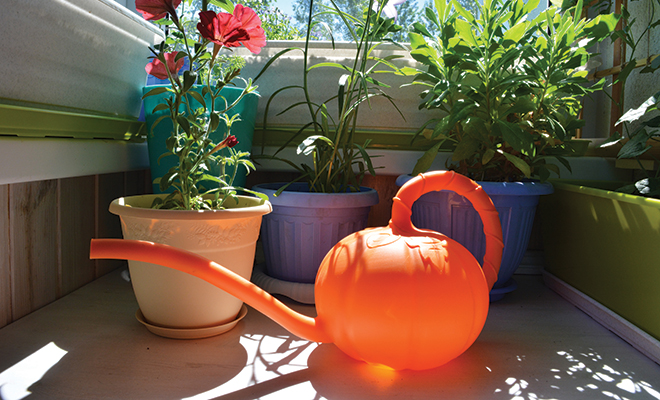
Balcony and Indoor Gardening Made Easy!
Imagine being able to snip a few leaves directly from a basil plant next time you make a caprese salad, instead of having to pay $3.98 at the grocery store for five stalks of basil, four of which will rot in the refrigerator, if you’re like me. Think about being able to dry a few handfuls of your own thyme and rosemary as gifts for your gourmet friends.
Gardening can be very rewarding, no matter the scale. Even if you don’t have acres of farmland available for cultivation, or any access to the ground story of your building at all, you can probably find a corner or two to experiment with balcony or container gardening. Here are several suggestions for apartment or condo dwellers who would like to test out their green thumbs.
First, plant what makes you happy. Do flowers brighten your mood? Do you want to have a few sprigs of a certain herb on hand? I started my garden by making a list of things I use often in my cooking and was tired of hunting down in the produce section at the grocery store. Or do you just want a little more green in your life?
When you’ve decided what you want to grow, check its temperature and light requirements to find an appropriate spot for it. If you have room on a balcony for plants, they’ll love the natural light, but you might need to watch the weather and protect them from extreme cold or heat. If you’re planting something that’s outside its natural climate, such as a fragile herb like cilantro in a hot area, or a lemon tree in an area with occasional frost, try keeping it indoors under a grow light to simulate sunlight. Special plant light bulbs are available at most hardware stores or online. I installed a standard-sized plant light bulb in a reading lamp next to my couch, so my end table plants can thrive even in my dim living room.
If you’re just starting an indoor or balcony garden, find containers suitable for your space. The taller your plant will grow, the deeper its roots need to go, so the higher the pot you’ll need. Some herbs and vegetables are bred for container varieties, so look for that labeling if you’re starting from seed. You can also buy live plants and repot them into containers using potting soil. Just make sure you buy pots with drainage holes so you won’t rot the roots with too much pooling water. Put a layer of gravel in the bottom of the pot before you add potting soil to help the soil drain well. You’ll want a drainage dish under each pot to catch extra water, especially for plants you’re going to keep indoors.
Try growing cucumbers, peppers or tomatoes in large containers on your balcony with tomato cages or trellises to support them. If your area is very sunny, avoid black pots because they will absorb sunlight and heat up the soil too much. You can also try adding a larger pot around the one the plant is in and filling in the empty space between pots with crumpled paper or moss, which you should dampen each time you water the plant.
After you’ve potted all your plants, you’ll need to keep watering them regularly, but don’t be tempted to soak them too much. Soggy roots and leaves can lead to fungus, which will damage or even kill plants. When you water, aim for the soil and the roots, not the leaves or flowers. Learning how to give your plants an appropriate amount of water can be a long process of trial and error, but as a general rule, let the soil dry out a bit before you water. After you water a plant, dump out any extra water standing in the drainage dish. Outdoor plants will go through more water than indoor plants, so check them daily.
Finally, here’s a mini gardening project that requires little to no investment in pots, soil or lights. Try growing your kitchen scraps in water! If you slice off green onions just above the white bulb and put the bulbs root-side-down in a glass of water, they’ll sprout a new green onion in less than a week. You can also place the roots of romaine lettuce in water to grow tender new lettuce leaves. These are easy ways to keep fresh salad ingredients on hand. If you’re not interested in growing food but just want to add a lively splash of green to your home, try sticking toothpicks into carrot tops or chunks of sweet potatoes to suspend them at the surface of a glass of water. Put them in a window and watch as beautiful green leaves emerge. ■
Sources: homeguides.sfgate.com, lifehacker.com, gardeningknowhow.com and almanac.com.







